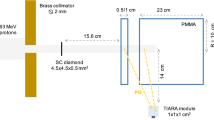Abstract
This paper reports on the last year's two major activities of our nuclear instrumentation group it the field of high rate and high resolution gamma spectrometry which were mainly devoted to the needs of activation analysis of short-lived nuclides. The first of the projects was the completion of a state-of-the-art spectrometry system for very high counting rates which has been installed at the fast inrradiation and transport facility of the TRIGA reactor and now is the main instrument for the short-lived work of our radiochemistry group. Based on a laboratory-designed gated integrator pulse processing system and equipped with an Ortec Gamma-X detector of 20% relative efficiency with cooled FET and transistor reset preamplifier, it exhibits a basic resolution of 2.3 keV at 1332 keV which at a counting rate of 1.1 million cps of60Co degrades to 3.4 keV. An essential feature of the system is a novel “quantitative” pileup rejector of the pulse counting type which has been specially designed for high rejection efficiency and at the same time, for the reliable exemption of valid events, and thus is a necessary prerequisite for quantitative real-time correction of counting losses by means of the Virtual Pulse Generator method. The second project included the successful implementation of the novel Preloaded Filter Technique (applied for patent), a new method for high resolution and high throughput processing of nuclear detector signals which, in contrast to conventional techniques, does not rely on a fixed pulse processing time per event which up to now was the main reason for pulse pileup and limited throughput, but, at the latest, terminates the filtering process of an individual event at the instant of arrival of the next event which results in optimized throughput and, at the same time, in a self-adapting, counting rate dependent shaping time. To that aim, the delta-noise filter of the system must be preloaded with the best estimate of the final result of the filtering process which is simply the unfiltered signal amplitude, to make sure that at the instant of termination of the filtering process the output of the filter deviates from the final value not more than by the decaying noise amplitude. Complemented by counting rate dependent step-noise filtering, this technique made possible the creation of “a spectrometry system for all purposes” which at low to medium counting rates is comparable to the best of the semi-Gaussian amplifiers and at high counting rates to the gated integrator. An experimental implementation of the Preloaded Filter combined with an Ortec Gamma-X detector of 15% relative efficiency resulted in a basic resolution of 1.9 keV at 1332 keV at a counting rate of 5000 cps slowly degrading to 3.2 keV at a counting rate of 650 000 cps of60Co.
Similar content being viewed by others
References
G. P. WESTPHAL, J. Radioanal. Chem., 70 (1982) 387, Austrian Patent 368291, US Patent 4476384.
G. P. WESTPHAL, Th. KASA, 5th. Intern. Conf. on Nuclear Methods in Environmental and Energy Research, 1984, Mayaguez.
G. P. WESTPHAL, Nucl. Instr. Methods, B 10 (1985) 1047.
ND 599 LFC, User's Manual (1984) Nuclear Data.
V. RADEKA, IEEE Trans. Nucl. Sci., NS-19 (1972) 412.
N. TACCETTI, Nucl. Instr. Methods, 225 (1984) 118.
G. P. WESTPHAL, Nucl. Instr. Methods, 138 (1976) 467.
Ortec 673, User's Manual (1984) Ortec.
D. A. LANDIS, C. P. CORK, N. W. MADDEN, F. S. GOULDING, IEEE Trans. Nucl. Sci., NS-29, (1982) No. 1, 619.
Canberra 2020. User's Manual (1980) Canberra.
G. P. WESTPHAL, Nucl. Instr. Methods, 163 (1979) 189.
VAX/VMS Spectroscopy Applications Package (1985) Nuclear Data.
M. BERTOLACCINI, C. BUSSOLATI, S. COVA, I. DE LOTTO, F. GATTI, Nucl. Instr. Methods, 61 (1968) 84.
Author information
Authors and Affiliations
Rights and permissions
About this article
Cite this article
Westphal, G.P., Kasa, T. & Roch, W. Trends in instrumentation for activation analysis of short-lived nuclides. Journal of Radioanalytical and Nuclear Chemistry, Articles 110, 9–31 (1987). https://doi.org/10.1007/BF02055005
Received:
Issue Date:
DOI: https://doi.org/10.1007/BF02055005




